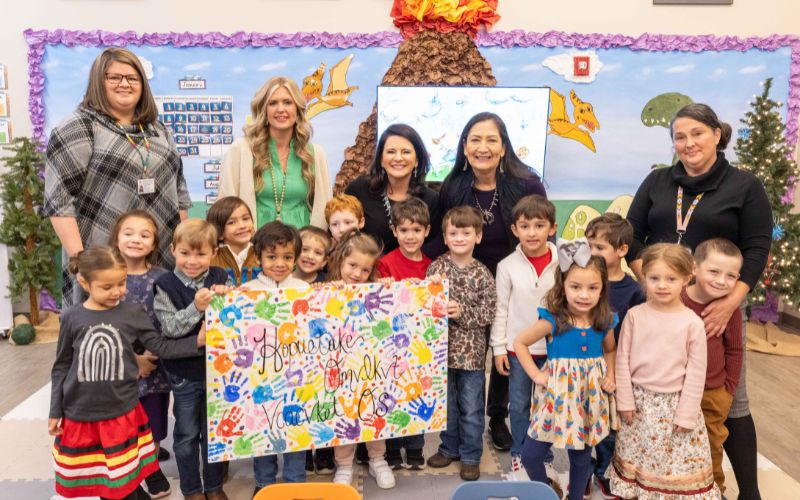
- Details
- By Native News Online Staff
Secretary of the Interior Deb Haaland (Laguna Pueblo) made a historic visit this week to the Poarch Band of Creek Indians, discussing how President Biden’s Investing in America Agenda is helping fund the Tribe’s infrastructure projects to provide better services for its members and surrounding community.
Haaland met with Tribal Council to hear first-hand about the only federally recognized tribe in Alabama’s journey and was briefed on the Tribe’s recent multi-million dollar investment into reliable, high-speed internet service for the reservation and surrounding communities.
“Secretary Haaland has been a tireless advocate for Tribes throughout her years of service to our country, both as the Secretary of the Interior and as a Member of Congress”, noted Stephanie A. Bryan, Poarch Band of Creek Indians Chair and CEO. “She truly understands how critically important it is for us, as an independent, sovereign Indian nation, to maintain a strong government-to-government relationship with the United States.”
This marks the first time that any member of the Department of Interior has been to the Tribe’s lands located in Atmore, Alabama. Haaland toured several locations on the reservation, including the Tribe’s Assisted Living Facility, Senior Activities Center, and the Poarch Creek Community Center, where preschool children shared a Mvskoke language presentation.
She continued on with her visit to the Poarch Creek Museum, where she received an in-depth guided tour of the Tribe's history, followed by a visit with Poarch Creek Tribal Leaders and several Tribal Princesses, where she was presented with the Tribe’s book, Woven Together.
Haaland created the Secretary’s Tribal Advisory Committee (STAC) in 2021. Its goal is to further strengthen the relations between the Department of Interior and Indian Country and ensure that Tribal Leadership Members have consistent communication with the Department’s leadership and staff.
“Personally, it has been both an honor and a privilege for me to have the opportunity to work with her and to see her commitment to finding solutions to some of the toughest problems facing Indian Country. She is a true public servant and our country is blessed to have her in this important role,” Bryan said in a statement,
More Stories Like This
Native News Weekly (August 25, 2024): D.C. BriefsUS Presidents in Their Own Words Concerning American Indians
Indigenous Actor Elaine Miles Reports Detention by Alleged ICE Agents
Happy Thanksgiving from Native News Online
Coming Up on Native Bidaské: Behind the Animation: Joey Clift Talks “Pow” and Native Storytelling
Help us tell the stories that could save Native languages and food traditions
At a critical moment for Indian Country, Native News Online is embarking on our most ambitious reporting project yet: "Cultivating Culture," a three-year investigation into two forces shaping Native community survival—food sovereignty and language revitalization.
The devastating impact of COVID-19 accelerated the loss of Native elders and with them, irreplaceable cultural knowledge. Yet across tribal communities, innovative leaders are fighting back, reclaiming traditional food systems and breathing new life into Native languages. These aren't just cultural preservation efforts—they're powerful pathways to community health, healing, and resilience.
Our dedicated reporting team will spend three years documenting these stories through on-the-ground reporting in 18 tribal communities, producing over 200 in-depth stories, 18 podcast episodes, and multimedia content that amplifies Indigenous voices. We'll show policymakers, funders, and allies how cultural restoration directly impacts physical and mental wellness while celebrating successful models of sovereignty and self-determination.
This isn't corporate media parachuting into Indian Country for a quick story. This is sustained, relationship-based journalism by Native reporters who understand these communities. It's "Warrior Journalism"—fearless reporting that serves the 5.5 million readers who depend on us for news that mainstream media often ignores.
We need your help right now. While we've secured partial funding, we're still $450,000 short of our three-year budget. Our immediate goal is $25,000 this month to keep this critical work moving forward—funding reporter salaries, travel to remote communities, photography, and the deep reporting these stories deserve.
Every dollar directly supports Indigenous journalists telling Indigenous stories. Whether it's $5 or $50, your contribution ensures these vital narratives of resilience, innovation, and hope don't disappear into silence.
 The stakes couldn't be higher. Native languages are being lost at an alarming rate. Food insecurity plagues many tribal communities. But solutions are emerging, and these stories need to be told.
The stakes couldn't be higher. Native languages are being lost at an alarming rate. Food insecurity plagues many tribal communities. But solutions are emerging, and these stories need to be told.
Support independent Native journalism. Fund the stories that matter.
Levi Rickert (Potawatomi), Editor & Publisher

